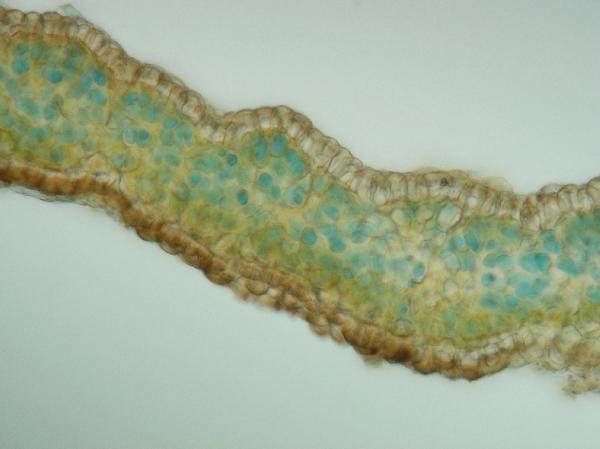Scytinium imbricatum (P.M. Jørg.) Otálora, P.M. Jørg. & Wedin
Fungal Divers., 64, 1: 290, 2013. Basionym: Leptogium imbricatum P.M. Jørg. - Lichenologist, 26: 7, 1994.
Synonyms:
Distribution: N - Ven (Nascimbene & al. 2021), TAA (Nascimbene & al. 2021, 2022), Piem (TSB 34145). C - Abr (Gheza & al. 2021, Di Nuzzo & al. 2021, Vallese & al. 2022)
Description: Thallus minutely squamulose, subgelatinous when wet, of ascending to erect, densely crowded, usually imbricate, dark brown to blue-grey 0.2-0.5(-1) mm wide, 50-85 μm thick, smooth squamules with indented to incised margins, forming dense, up to 3 cm wide cushions; lower surface blue-grey, with sparse tufts of long-celled, whitish hapters. Thallus paraplectenchymatous throughout, the hyphal cells 5-10 μm wide. Apothecia very rare, lecanorine, sessile and constricted at base, up to 1 mm across, with a concave to slightly convex, brown disc, a soon excluded thalline margin, and a usually paler proper margin. Proper exciple subparaplectenchymatous; epithecium brownish; hymenium colourless, 100-150 μm high; paraphyses coherent, mostly simple, 1-2 μm thick at mid-level, the apical cells slightly swollen; hypothecium colourless. Asci 8-spored, narrowly clavate, the apex strongly thickened, the apical dome K/I+ pale blue, with a downwardly projecting K/I+ deep blue tubular structure. Ascospores muriform, hyaline, ellipsoid, 20-35 x 7-15 μm. Photobiont cyanobacterial (Nostoc, the cells in clusters or in short chains). Spot test: all negative. Chemistry: without lichen substances. Note: on more or less calciferous ground in alpine grasslands; likely to occur throughout the Italian Alps, but formerly filed under pulvinate forms of S. gelatinosum and S. lichenoides . For further details see Bertrand & al. (2022).
Growth form: Squamulose
Substrata: soil, terricolous mosses, and plant debris
Photobiont: cyanobacteria, filamentous (e.g. Nostoc, Scytonema)
Reproductive strategy: mainly sexual
Commonnes-rarity: (info)
Alpine belt: rare
Subalpine belt: rather rare
Oromediterranean belt: absent
Montane belt: absent
Submediterranean belt: absent
Padanian area: absent
Humid submediterranean belt: absent
Humid mediterranean belt: absent
Dry mediterranean belt: absent
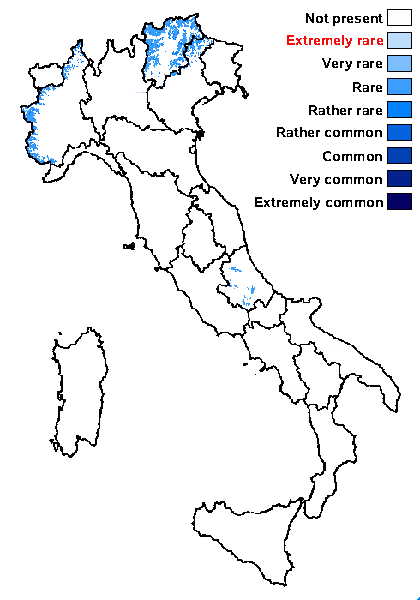
Predictive model
Herbarium samples
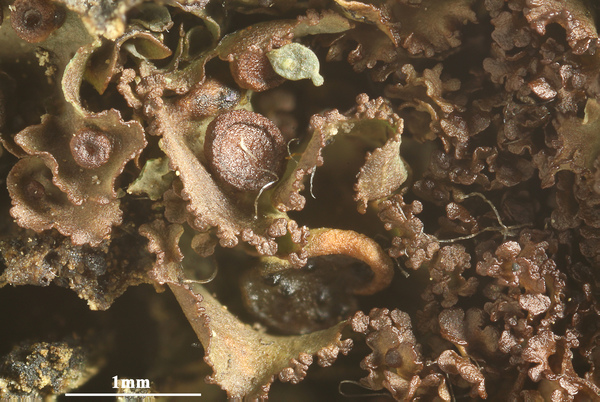
Felix Schumm - CC BY-SA 4.0
[19712], Venezuela, Merida, District Rivas Davila, Paramo la Negra, ca. 20 km W of Bailadores, on the ground on plant debris, 2750 m, 8°15' N, 71°50' W. Leg. K. & A. Kalb, 12.8.1989, det. A. Aptroot. KALB: LICHENES NEOTROPICI NR. 647
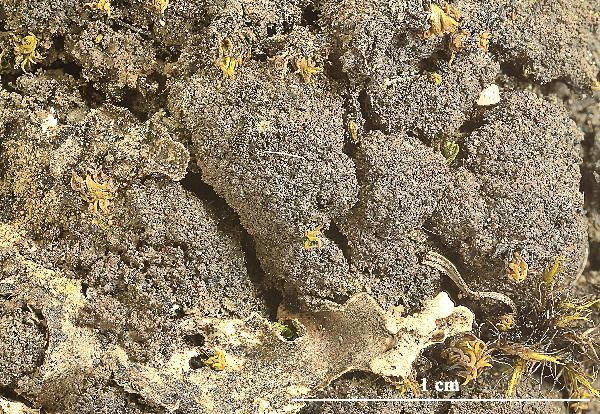

Felix Schumm - CC BY-SA 4.0
[21028], Austria , Kärnten (=Carinthia), Eastern Alps, Ankogel Group.
1.1 km north of the centre of Mallnitz, 46°59'55'' N, 013°10'26'' E, 1205
m, railway embarkment /granite gravel, west-northwest exposed), on
cushions of bryophytes and layers of fine earth. Leg. et det. F. Berger
(31546), 11.06.2017.- EX W. OBERMAYER: DUPLA GRAECENSIA
LICHENUM NR. 1273.
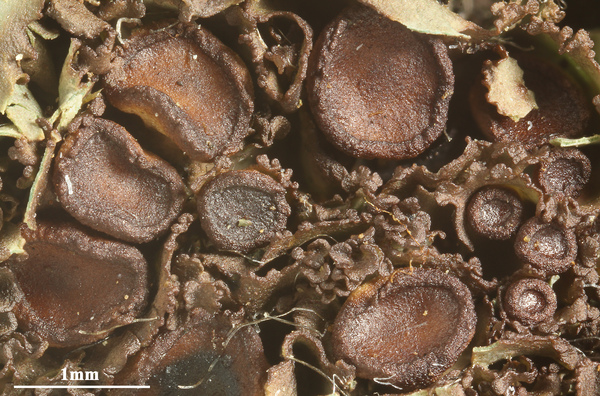
Felix Schumm - CC BY-SA 4.0
[19712], Venezuela, Merida, District Rivas Davila, Paramo la Negra, ca. 20 km W of Bailadores, on the ground on plant debris, 2750 m, 8°15' N, 71°50' W. Leg. K. & A. Kalb, 12.8.1989, det. A. Aptroot. KALB: LICHENES NEOTROPICI NR. 647
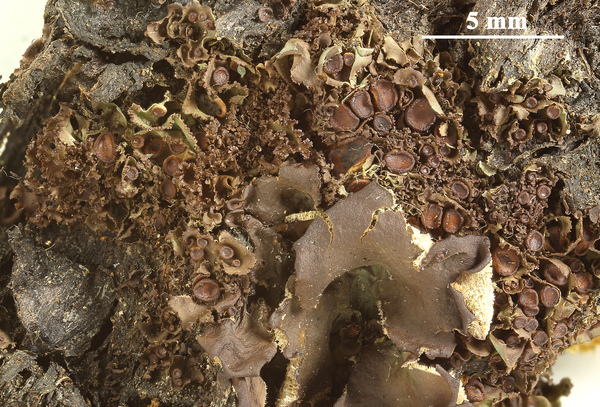
Felix Schumm - CC BY-SA 4.0
[19712], Venezuela, Merida, District Rivas Davila, Paramo la Negra, ca. 20 km W of Bailadores, on the ground on plant debris, 2750 m, 8°15' N, 71°50' W. Leg. K. & A. Kalb, 12.8.1989, det. A. Aptroot. KALB: LICHENES NEOTROPICI NR. 647
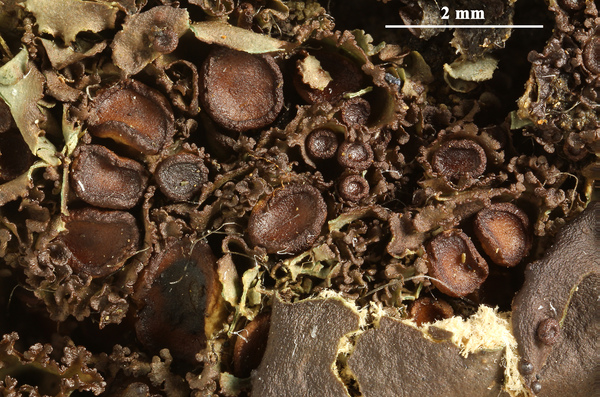
Felix Schumm - CC BY-SA 4.0
[19712], Venezuela, Merida, District Rivas Davila, Paramo la Negra, ca. 20 km W of Bailadores, on the ground on plant debris, 2750 m, 8°15' N, 71°50' W. Leg. K. & A. Kalb, 12.8.1989, det. A. Aptroot. KALB: LICHENES NEOTROPICI NR. 647
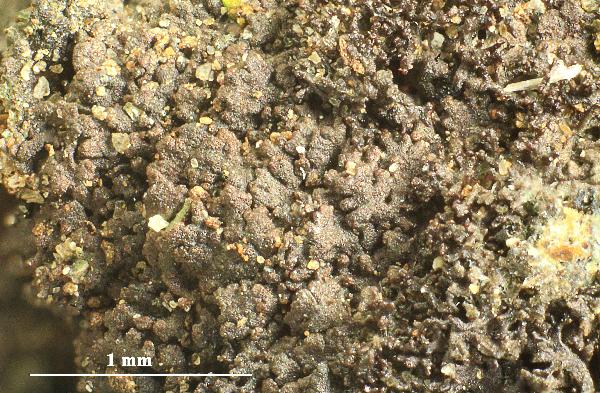

Felix Schumm - CC BY-SA 4.0
[21028], Austria , Kärnten (=Carinthia), Eastern Alps, Ankogel Group.
1.1 km north of the centre of Mallnitz, 46°59'55'' N, 013°10'26'' E, 1205
m, railway embarkment /granite gravel, west-northwest exposed), on
cushions of bryophytes and layers of fine earth. Leg. et det. F. Berger
(31546), 11.06.2017.- EX W. OBERMAYER: DUPLA GRAECENSIA
LICHENUM NR. 1273.
Growth form: Squamulose
Substrata: soil, terricolous mosses, and plant debris
Photobiont: cyanobacteria, filamentous (e.g. Nostoc, Scytonema)
Reproductive strategy: mainly sexual
Commonnes-rarity: (info)
Alpine belt: rare
Subalpine belt: rather rare
Oromediterranean belt: absent
Montane belt: absent
Submediterranean belt: absent
Padanian area: absent
Humid submediterranean belt: absent
Humid mediterranean belt: absent
Dry mediterranean belt: absent

Predictive model
| Herbarium samples |

Felix Schumm - CC BY-SA 4.0
[19712], Venezuela, Merida, District Rivas Davila, Paramo la Negra, ca. 20 km W of Bailadores, on the ground on plant debris, 2750 m, 8°15' N, 71°50' W. Leg. K. & A. Kalb, 12.8.1989, det. A. Aptroot. KALB: LICHENES NEOTROPICI NR. 647


Felix Schumm - CC BY-SA 4.0
[21028], Austria , Kärnten (=Carinthia), Eastern Alps, Ankogel Group. 1.1 km north of the centre of Mallnitz, 46°59'55'' N, 013°10'26'' E, 1205 m, railway embarkment /granite gravel, west-northwest exposed), on cushions of bryophytes and layers of fine earth. Leg. et det. F. Berger (31546), 11.06.2017.- EX W. OBERMAYER: DUPLA GRAECENSIA LICHENUM NR. 1273.

Felix Schumm - CC BY-SA 4.0
[19712], Venezuela, Merida, District Rivas Davila, Paramo la Negra, ca. 20 km W of Bailadores, on the ground on plant debris, 2750 m, 8°15' N, 71°50' W. Leg. K. & A. Kalb, 12.8.1989, det. A. Aptroot. KALB: LICHENES NEOTROPICI NR. 647

Felix Schumm - CC BY-SA 4.0
[19712], Venezuela, Merida, District Rivas Davila, Paramo la Negra, ca. 20 km W of Bailadores, on the ground on plant debris, 2750 m, 8°15' N, 71°50' W. Leg. K. & A. Kalb, 12.8.1989, det. A. Aptroot. KALB: LICHENES NEOTROPICI NR. 647

Felix Schumm - CC BY-SA 4.0
[19712], Venezuela, Merida, District Rivas Davila, Paramo la Negra, ca. 20 km W of Bailadores, on the ground on plant debris, 2750 m, 8°15' N, 71°50' W. Leg. K. & A. Kalb, 12.8.1989, det. A. Aptroot. KALB: LICHENES NEOTROPICI NR. 647


 INDEX FUNGORUM
INDEX FUNGORUM
 GBIF
GBIF
 DOLICHENS
DOLICHENS
